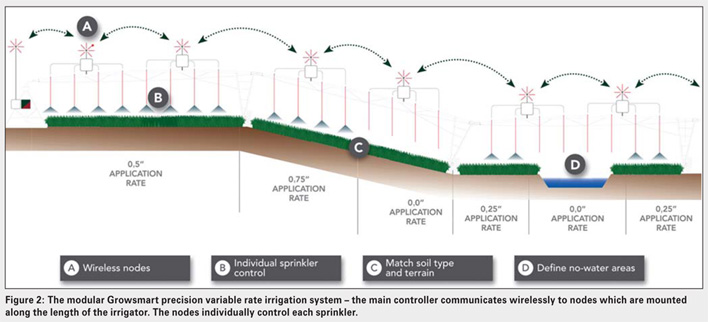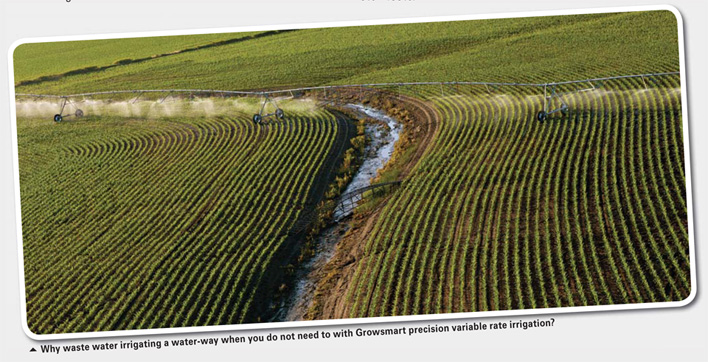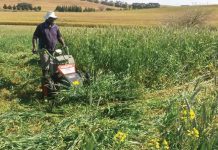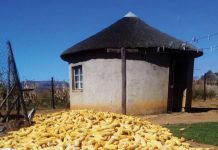November 2015
JACO NEL, technology and field service manager: Lindsay
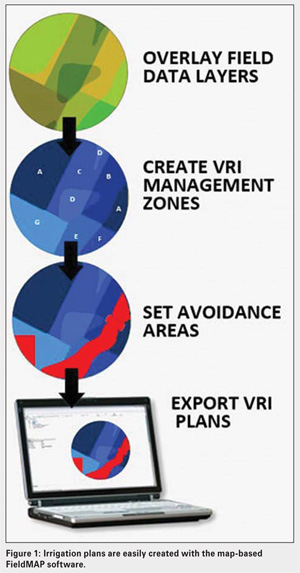 Soil and topography varies in most centre pivot circles with some soil types and areas that will become water locked while others will remain too dry to produce optimally. Due to this, the yield will also fluctuate. These low and high spots and soils create the need to vary water applications.
Soil and topography varies in most centre pivot circles with some soil types and areas that will become water locked while others will remain too dry to produce optimally. Due to this, the yield will also fluctuate. These low and high spots and soils create the need to vary water applications.
Variable rate irrigation technology allows you to apply exactly the right amount of water to specific areas under your irrigator – giving full control to maximise yields and profitability. The Growsmart precision variable rate irrigation system achieves this by individually pulsing sprinklers on and off, while also controlling the irrigator speed to modify the application depth along the length of the irrigator.
Control of the irrigator speed and individual valves allows the amount of water applied to each area to be carefully regulated, optimising water application.
There are many agricultural applications where irrigation efficiency can be improved through the use of variable rate irrigation. The technology has proven benefits for farms irrigating over varying soil types or with different crops planted under the one irrigator. Water savings and yield increases are achievable by reducing irrigation to high run-off areas and low areas prone to getting wet and boggy. Irrigation can also be completely avoided over buildings, tracks, roads, water-ways, non-productive and environmentally sensitive areas.
First commercialised in 2008, Growsmart precision variable rate irrigation was the industry’s first true precision variable irrigation system. Growers have reported many advantages achieved from installing the system, including record crop yields, increased pasture production, significant irrigation water savings, a drop in the power bill due to reduced energy requirements and reduced maintenance costs of farm tracks and lanes.
Independent research has indicated that in any one year, variable rate irrigation can save between 9% and 26% of irrigation water. In practise producers in Australasia have been achieving water savings of up to 35% by tailoring irrigation to the water requirements of variable soils underneath an irrigator. These savings are possible through the use of the intelligent precision variable rate irrigation system enabling application rates over wet areas to be reduced and water completely turned off over tracks, drains, buildings and unproductive areas.
Furthermore, because the precision variable rate irrigation system only delivers water when and where it’s programmed to, there are no wasted pumping costs. Calculations show that 9% to 26% water savings equates to 27 kg – 77 kg of CO2-eq/ha/yr energy savings. Rather than farming to the limitations of an existing irrigation system, several crops that require varying amounts of water can be grown under the one irrigation system when variable rate irrigation is installed, giving you the ability to maximise the yields of each crop. Fertiliser and chemicals can also be efficiently applied exactly where they’re needed with the pinpoint accuracy of precision variable rate irrigation technology which can be a real saving compared to blanket applications.
Precision variable rate irrigation solves common over-watering issues inherent to many machine set-ups such as laterals, geo-laterals and part circles. For instance, irrigation plans can be set up to ramp down application rates when approaching the reversing point for a part circle or lateral and then ramp up again when heading away from the barricade. The intelligent system can also detect when a geo-lateral changes from lateral to pivot mode, altering the sprinkler rates accordingly to even out the application.
Irrigation plans are created with FieldMAP, precision variable rate irrigation’s custom mapping programme. The software is preloaded with applicable irrigator data, and then it is customised for each system after which it is ready to generate irrigation plans. Water application can be optimised for both the area irrigated and the water source, for instance the maximum consented water volume or flow rate.
Field information relating to the irrigated area can be defined by aerial photographs, electromagnetic survey maps, available water holding capacity maps, crop parameters, infrared image maps, and polygons exported from Google Earth™ and user-defined GPS information. User-defined GPS information often identifies avoidance areas such as races/tracks, ponds, troughs, specific paddocks or unproductive areas. As field information is constructed in “layers”, many different types of field information may be considered when creating irrigation plans.
Within the map, “management zones” are set from the field information in which different application rates are applied. As the precision variable rate irrigation system allows individual control of every sprinkler along an irrigator, there are no spatial or profile limitations to the management zones.
Precision variable rate irrigation plans can be either manually imported into the precision variable rate irrigation controller or transmitted wirelessly. Once the plan is loaded onto the variable rate irrigation controller, it is ready to apply. The variable rate irrigation controller reads the plan and sends a message to wireless nodes along the length of the pivot. Nodes control each individual sprinkler to turn on or off, or pulsate according to field position and desired application rate. Each sprinkler is controlled by a magnetic latching solenoid valve that’s built to last.
The precision variable rate irrigation system has several operation modes, one of which allows you to set irrigation depths (e.g. 10 mm, 5 m and 8,5 mm) on your map and then the variable rate irrigation controller takes care of the rest, pulsing valves and controlling the speed of the irrigator towers accordingly. Another option allows you to set percentages. You can set areas to receive any amount from 0% – 100%.
You then set the application depth on the irrigator’s controller and the variable rate irrigation controller will pulse the valves to lower the application depth to the percentage set on the map.
The capital layout of a variable rate irrigation system is influenced by the number of sprinklers on the irrigator, spacing between the outlets and the length of the structure. Cost estimates and return on investment calculations show payback terms of five to ten years. This depends on the severity of the problem, potential of soils with the right irrigation and the value of the crop.
Growsmart precision variable rate irrigation is compatible with centre pivots, laterals, pivoting laterals and reverse pivoting laterals. It can be installed on new irrigation systems or as an add-on to existing systems.
For more information, visit www.grow smartprecisionvri.com. You can contact theauthor directly at the Lindsay Africa head officeat 021 986 8900.
Publication: November 2015
Section: Focus on




